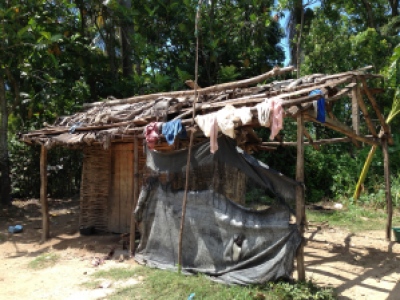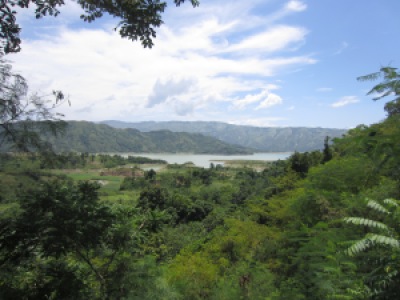It is our first full day in Haiti. As a global health fellow with UCSF I have traveled here with global health fellows across the country to be introduced to Partners in Health (PIH) and to Haiti. We were brought to a crude wooden shelter. It is from these wooden walls that the community health workers run the malnutrition program for this tucked away rural village and serve as the first line providers in the larger health network. However, it was not the malnutrition program for which we had been brought—our destination was more remote and in a place where vehicles are unable to pass.

We start our walk: 5 visiting doctors, a community health worker, and a woman from the community with her grandchild. The “road” we embark upon is a stone path with the mountains rising before us in the distance. We follow the community health worker for a fourth of a mile until we stumble upon a dirt trail obscured until the last moment by overgrown brush. The trail dips into a small stream and emerges on the other side. I clumsily forge through the moving water and climb the muddy incline on the opposite side, using my hands to grasp at rocks for balance. In contrast, the seasoned grandmother does the task gracefully with the toddler perched upon her hip. The stream serves as the community’s water source—today it is clear but I am told this is not always so. The grandmother goes on to explain that in the rainy season the stream becomes a river, swelling over the banks and further isolating the community on the other side. We continue our walk along the winding path, a steady but not arduous climb that still manages to leave me winded.
We happen upon our first home at the peak of the hill. I look down at my watch and notice that more than thirty minutes have passed since our departure. The matriarch of the family introduces her family of fourteen. They are sharecroppers and rent this plot of land. Their two-bedroom shelter is concrete with a recently added metal roof paid for by collecting pooled money from all the children. The concrete gives it a sense of permanence and sturdiness that is lacking in many homes in the area. The community health worker knows this family well; one of the children is enrolled in the malnutrition program and a couple of the others are recent graduates. A few banana trees serve as their food source and as trading collateral in this part of Haiti that is largely based on a barter system. Their earnings are often too little and require a loan from others in the community. The school fee of $5 a month per child is not even a thought in their restricted budget. We quickly notice open sores on one of the children’s heads and recognize the culprit to be scabies. Scabies are mites that are highly contagious through touch and cause an intensely itchy rash, which when scratched can become superinfected. The mites quickly infest homes like this one with such close living quarters. The family reports that the child was seen by a nurse a few months ago but it had failed to improve. We encourage them to return to the clinic to receive treatment for the whole household and explain how to place clothes all clothes on the hot roof to kill the mites. The community health worker vows to follow-up.
We continue on the trail. In another 10 minutes, we stop with the grandmother who has accompanied us on our journey. We take shade from the unyielding sun beneath a tree and are greeted by her other two grandchildren. Only the youngest is enrolled in the malnutrition program. Yet, it is apparent all three would benefit from Neurimamba, a peanut butter fortified with extra vitamins and calories. The grandmother had left the two elder children, the oldest being 10 years old, behind at the home while away. She has to make the trip every two weeks and finds it too difficult with all three children in tow. The childrens’ mother left to Port-Au-Prince months ago to find work and has not returned. The grandfather was paralyzed in a work accident and stays in another village across the river as it is too arduous a climb for them to transport him back and forth. This resilient woman owns the land they live on and has a few banana trees and trees, like the one we stand under, that bear nuts. As we listen to the woman’s narrative, the 10-year-old proudly shows us how he grinds the nuts to make the oil that can be sold for cooking or placed on hair and skin. He does not attend school for the same reason as the prior family, but it is obvious he has achieved wisdom and responsibility beyond his tender age. The grandmother senses that our visit is coming to an end and implores us to check on a neighbor who needs our attention. This was to be our last home as 1.5 hours has passed since our departure. However, we sense her urgency and look to our community health worker to lead the way.

The community health worker knows the family that the grandmother identified well so we follow her further up the hill. We are told that the gentleman has been unable to walk for sometime now, maybe even years. Recently he “speaks out his head” and is hard to redirect when he becomes belligerent. In addition, his intake of fluids and food has been diminishing. On exam, we see a man lying on a blanket upon the dirt floor, covered partially by a single sheet that is unable to hide his atrophied lower extremities. We are able to awaken him with time but he doesn’t follow commands though he appears to move both of his arms and legs. It is unclear what is the cause of his recent deterioration, but his condition and apparent malnutrition and dehydration have us inclined to take him for further evaluation at the local clinic and attached small hospital. However, our willingness is not the barrier that prevents his access of care. The only way to immediately transport him would be by “moto”, and it is unlikely he can tolerate sitting on a motorcycle. As an alternative, we consider the option of getting more men to help carry him back the way we came. This suggestion is met with resistance by the family– “Once at the hospital, who will care for him?”. As the hospitals and clinics are greatly understaffed, family members are required to pay vigil at the bedside and to carry out duties such as feeding, dressing and cleaning. “Who can we spare?” Even if a family member is able to go, this would have the consequence of lost days’ wages which cannot be sacrificed in a family where ends are barely met. “How will we pay for the materials needed”. Though user fees had been greatly reduced, in times of supply shortages, families have to scrounge for money to buy these materials outside the hospital and provide them to the hospital for care. In the end, these barriers proved to be insurmountable. It was agreed that the Community Health Worker would make an extra trip to return in a couple of days and check on the patient’s progress while the family considers the options. As we leave, the gentleman begins a loud chanting song to which the family members shake their heads as if to say, “We don’t know what to do with him.”

As we retrace our steps, I experienced the journey differently. I become all too aware of its difficult nature that further estranges these people from food, education and, of course, healthcare. However, as the home visits proved, it is not the geographical barrier that is the greatest. In each home my list of social determinants that serve as additional obstacles grew longer, all of which were manifestations of the overarching hurdle of poverty. It was this third home that emphasized the importance of active case finding. I am reminded that the most desperate cases will never seek help—their social determinants too overwhelming for the patient or the family to even sound an alarm since the trade-off of seeking care has too many other consequences to bear. On our last night in Haiti, Pere Eddie, who is a long-term advocate of the poor, Haitian priest and mental health worker with ZL encouraged us,“Go to the people. Live with them. Learn from them. Love them. Start with what they know. Build with what they have.”[1] Indeed, if we wish to empower our patients, then we must first go to the people and live with the people to deconstruct these barriers one at a time. It is community health workers that do exactly that, sounding the alarm and calling us to action.
Ami Waters, MD
UCSF Global Health Hospital Medicine Fellow
[1] Quote from Lao Tzu, Chinese Taoist philosopher 600- 531 BC


